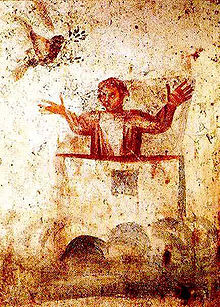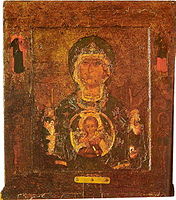Orans


Orans, a loanword from
History
The orans posture is widespread in the art of the
The orans position is seen throughout the
In

The orans posture experienced a revival within Pentecostalism and Charismatic Christianity under the umbrella of the contemporary worship movement of the mid-20th century.[10][12][13]
Depictions in art
Orans was common in early
Numerous Biblical figures, for instance, depicted in the
The earlier orantes were depicted in the simplest garb, and without any striking individual traits, but in the fourth century the figures become richly adorned, and of marked individuality, an indication of the approach of historic art. One of the most remarkable figures of the orans cycle, dating from the early fourth century, is interpreted by Wilpert as the Blessed Virgin interceding for the friends of the deceased. Directly in front of Mary is a boy, not in the orans attitude and supposed to be the
The Platytéra, a
Some orans-type Eastern Orthodox icons of the Virgin Mary
-
Orans (catacombs of Rome), first half of IV c.
-
Orans of Kyiv. Mosaic. XI c.
-
Orans in Kyiv Saint Sophia cathedral.
-
Our Lady of the Sign icon. Veliky Novgorod. First half of XII c.
-
Inexhaustible Chalice icon. Serpukhov. XIX c.
See also
References
- ^ ISBN 978-0-8308-7917-5.
Because early Christians were Jewish, they naturally lifted their hands in prayer, like the veiled orans figures in the catacombs. The apostle Paul advised the earliest Christians, "I want men everywhere to lift up holy hands in prayer, without anger or disputing" (1 Tim 2:8) and early church literature indicates the widespread practice of this prayer position. In the first through third centuries, Marcus Minucius Felix, Clement of Rome, Clement of Alexandria and Tertullian either advised Christians to lift up hands in prayer, or at least mentioned the practice.
- ^ ISBN 978-0-8028-0846-2.calls "lifting holy hands" in prayer (a gesture stretching from the orans pictures in the catacombs to modern Pentecostalism), in penitential or submissive kneeling, in reverential genuflections, in the ascetical practices suggested by the apostle Paul's athletic imagery (1 Cor. 9:24-27; 1 Tim. 6:6-16; 2 Tim. 4:7f).
The piety shows itself in the informal signing of one's body with the sign of the cross, in what 1 Timothy 2:8
- ^ a b c d e f g "Why do we extend our arms when praying the Our Father and at other times during the Maronite anaphora?". Living Maronite. 27 November 2016. Retrieved 24 April 2022.
This is sometimes referred to as the Orans posture. The posture is explicitly directed by the presently used Maronite Qorbono. The posture has in its origins an association with prayer. It can be found in the Old Testament. In Psalm 141 we pray: "Let my prayer be counted as incense before you, and the lifting up of my hands as an evening sacrifice." The posture is referred to in the New Testament at 1 Timothy 2:8, in the instructions concerning prayer: "I desire, then, that in every place the men should pray, lifting up holy hands without anger or argument;" We see the posture in the early Church catacomb icons as depicted here. The icon perhaps gives us the best indication of why the posture is presently used in the Maronite Mass.
- ^ a b Dawood, Bishoy (8 December 2013). "Stand, Bow, Prostrate: The Prayerful Body of Coptic Christianity: Clarion Review". Clarion Review. Retrieved 27 July 2020.
Standing facing the East is the most frequent prayer position. The person praying usually holds his or her hands outwards in the 'orans' position, which is a common Christian position of prayer, frequently portrayed in ancient Christian art, including in Coptic iconography. At other times, hands may be kept down to the sides or held together as a sign of standing in humility before God. Some people choose to hold a cross in their hands as they stand in the orans position; in this case, the sign of the cross traced over the body ends with kissing the cross.
- ^ David M. Calabro, "Gestures of Praise: Lifting and Spreading the Hands in Biblical Prayer", in David Rolph Seely, Jeffrey R. Chadwick, and Matthew J. Grey (eds.),Ascending the Mountain of the Lord Temple, Praise, and Worship in the Old Testament (2013).
- ^ Byrum, Enoch Edwin (1904). "Ordinances of the Bible: Showing the Ordinances that Have Been Abolished, and Those Still in Vogue". Gospel Trumpet Company. p. 114.
- ^ ISBN 978-0-8146-1036-7.
This Jewish gesture of prayer was apparently adopted by Christians for private as well as communal prayer.
- ^ a b c d Cohick, L. H., & Hughes, A. B. "Christian Women in Catacomb Art." Christian women in the patristic world: Their influence, authority, and legacy in the second through Fifth Centuries, 65-88. Baker Academic. 2017.
- )
- ^ a b Stephen Burns, SCM Studyguide to Liturgy (Hymns Ancient & Modern Ltd, 2006), 62.
- ^ "Liturgical Gestures." New Catholic Encyclopedia. second edition, volume 8. Detroit: Gale, 2003. 646-650. Gale Virtual Reference Library. Web. 7 February 2012.
- ^ Paul Harvey and Philip Goff, The Columbia documentary history of religion in America since 1945 (Columbia University Press, 2005), 347.
- ^ Larry Witham, Who shall lead them?: the future of ministry in America (Oxford University Press, 1 July 2005), 134.
- ISBN 978-0-536-41910-1.)
{{cite book}}: CS1 maint: multiple names: authors list (link - ^ a b c d Herbermann, Charles, ed. (1913). . Catholic Encyclopedia. New York: Robert Appleton Company.
- ^ Wilpert "Ein Cyklus christologischer Gemälde aus der Katakombe der Heiligen Petrus und Marcellinus" (Freiburg, 1891);
- ^ a b Torjesen, K. (2020). The Early Christian Orans: An Artistic Representation of Women's Liturgical Prayer and Prophecy. In Women Preachers and Prophets through Two Millennia of Christianity (pp. 42-56). Berkeley: University of California Press.
Sources
 This article incorporates text from a publication now in the public domain: Herbermann, Charles, ed. (1913). "Orans". Catholic Encyclopedia. New York: Robert Appleton Company.
This article incorporates text from a publication now in the public domain: Herbermann, Charles, ed. (1913). "Orans". Catholic Encyclopedia. New York: Robert Appleton Company.





